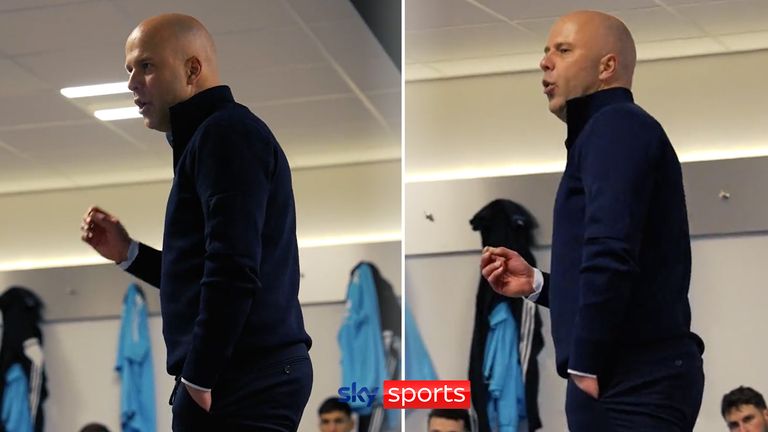Liverpool remain in talks over appointing Arne Slot after Feyenoord turned down their opening offer for the head coach; Slot has now publicly revealed he wants to become the new Liverpool boss and is “confident” the clubs will find an agreement for him to move to Anfield

Melissa Reddy shares the latest on Feyenoord’s Arne Slot’s emergence as the front-runner to replace Jurgen Klopp at Liverpool
Liverpool and Feyenoord are heading towards finalising an agreement for Arne Slot to become Jurgen Klopp’s successor.
Talks have progressed positively and while sources in the Netherlands have mentioned a figure of £9.85 million, Sky Sports News has been told no amount has been settled on yet and negotiations are ongoing.
Slot, who led the Dutch club to only their second Eredivisie title this century last season, featured on Liverpool’s list of candidates from the start of a long, rigorous process and topped it when they finished due diligence on all the key criteria.
Xabi Alonso, the outstanding candidate for every top club seeking a new manager this summer, ruled himself out of contention by remaining at Bayer Leverkusen.

Liverpool manager Jurgen Klopp appeared to endorse his potential successor Slot, describing him as a ‘good coach and a good guy’
- The making of Arne Slot: Why he is right for Liverpool
- Slot to Liverpool sums up search for ‘untainted’ coaches
- Klopp: Slot potential appointment good for Liverpool
- Stream Sky Sports with NOW | Get Sky Sports
- Get Sky Sports on WhatsApp | Download the Sky Sports app
Sporting coach Ruben Amorim had made Liverpool’s shortlist, and despite the external noise over him, the club always maintained he was not the leading or preferred option.
He ticked several requirements, but his playing approach – particularly using three at the back – and long-term vision did not fit the current squad nor the philosophy implemented through all age groups at Liverpool.
Suggestions that financial reasons were behind Amorim not being the frontrunner for the Anfield job has been termed fiction.
There has also been scepticism around the reasons for the 39-year-old’s very public meeting with West Ham, with one intermediary suggesting Amorim was trying to pressure Liverpool by showing them he had other options.
The club had already judged Slot as the better football fit before that point, as well as a superior communicator and connector.
- WhatsApp POLL: Is Slot the right man to replace Klopp?

Watch Slot give an inspirational team talk following a huge win against Ajax last season – his side then went on to win the Eredivisie
The character references sourced for every candidate also established him as a top pick.
On Thursday, Slot indicated he was confident a deal would be agreed. “Everybody understands Feyenoord will want to receive as much money as they can get, but I get the feeling that they will not begrudge me this move,” he said.
“I expect that things will become clearer over the next few days.”
Why are Liverpool keen on Slot?
Who is Slot and why do Liverpool want him?
- Age: 45
- Trophies won: Eredivisie 2022/23, KNVB Cup 2023/24
- Playing style: Aggressive, full-throttle
- Preferred formations: 4-2-3-1 or 4-3-3
Slot, who secured the Dutch Cup last weekend and led Feyenoord to their first title in six years last season, appeals to Liverpool due to his aggressive, full-throttle style.
He has drilled his team to be adept at turning defensive actions into shooting opportunities and they top the Eredivisie for tackles won in the opposition’s final third.
Feyenoord have the best defence in the league and the second-best offensive metrics.

Image: Slot is expected to be the man to replace Klopp
Slot has proved capable of improving individuals as well as the collective, while operating on a smaller budget than his core competitors, and his penchant for a 4-2-3-1 or 4-3-3 formation fits Liverpool’s squad.
Slot has previously been approached by Tottenham, Chelsea and Leeds. He signed a new contract last May to keep him at Feyenoord until 2026 but has referenced a desire to make the next step in his career.

Slot says he is confident the club will reach an agreement to allow him to join Liverpool
Slot has a strong track record of player development and outperforming his budget and resources in comparison to rivals at both AZ Alkmaar and Feyenoord. This is important when we scan the football landscape and how it’s going to change.
We’ve seen the teeth of the Premier League’s Profitability and Sustainability rules, and with some clubs pushing for “anchoring” and a hard salary cap to be introduced, the importance of work on the training pitches, being able to bring through young talent, and operate well within means is going to be more pronounced.
Under Fenway Sports Group, Liverpool have been run in a healthy, sustainable way and it is sensible to recruit a manager who can continue to maximise resources.

Feyenoord boss Arne Slot had an awkward exchange with Sky Sports News reporter Gary Cotterill as he was asked about taking the Liverpool job Similarities between Slot’s Feyenoord and Klopp’s Liverpool
- Feyenoord have won possession in the final third more than any team in Europe’s top five leagues, with Liverpool in second
- The average distance from their own goal when winning possession in open play: Feyenoord 45.2 metres, Liverpool 44.6m
- High turnovers: Liverpool 353, Feyenoord 344
- Average possession in the league: Feyenoord 62%, Liverpool 61.4%
Most of the candidates under consideration by Liverpool ticked that box, but Slot’s playing approach and philosophy, which marries so well with what Klopp has implemented at the club, set him apart.
It means there is no massive tactical upheaval or adaptation. Liverpool have one vision and playing style running through all age groups, which dictates the stylistic profile they recruit for, so it is sensible to continue with that.
The leap from the Eredivisie to a team that wants to win the Premier League and be a dominant force in Europe in a huge one, but every potential successor to Klopp carries risk.
Carra: Liverpool’s move for Slot shows lack of top managers

Jamie Carragher feels that Slot may find the step up from Feyenoord to Liverpool difficult as he would have to meet the club’s current demands to compete for the biggest trophies every season
Jamie Carragher says Liverpool’s move for Slot demonstrates the lack of “top managers” currently available.
Speaking to Sky Sports, former Liverpool defender Carragher said: “From Feyenoord to Liverpool is a huge jump and I think it shows at this moment that there’s probably a dearth of real top managers out there, when you look at who Liverpool are going for.

The Guardian’s Jonathan Liew and The Times’ Charlotte Duncker discuss the possibility of Slot becoming Klopp’s successor
“Initially it was Xabi Alonso – it’s only his first full season as a manager – then there was talk of Ruben Amorim from Sporting, who’s only 39. Now Arne Slot is the favourite.”
Carragher added the scenario potentially facing Slot at Anfield differs from the one Klopp inherited in 2014 after his time in charge of Borussia Dortmund, or the one Rafa Benitez walked into in 2004 after leaving Valencia.
“I don’t think it’s like Benitez coming in, or Klopp,” he said. “Benitez coming in on the back of two LaLiga titles and a UEFA Cup, or Klopp winning a couple of league titles and getting to a Champions League final. Liverpool were actually in a different space then.

Gary Neville gives his take on Liverpool’s move for Slot
“That Liverpool team, certainly under Benitez that I was part of, we were the team trying to qualify for the top four. The same with Klopp when he came in.
“But Liverpool are in a different era now. They actually fancy themselves to challenge for the Premier League every season. Next season, in the Champions League they’d expect to get to the quarter-finals at least.
“I think it’s a huge jump but he’s obviously a great coach with a great track record so far. We’ll see.”
Essential Questions Podcast: Is Slot the man for Liverpool?
Ron Walker is joined by Sky Sports News’ senior reporter, Melissa Reddy and Sky Sports football journalist Adam Bate to discuss Slot’s potential move to Liverpool as Klopp’s successor.
Subscribe now on: Apple Podcasts | Spotify
Spotify This content is provided by Spotify, which may be using cookies and other technologies. To show you this content, we need your permission to use cookies. You can use the buttons below to amend your preferences to enable Spotify cookies or to allow those cookies just once. You can change your settings at any time via the Privacy Options. Unfortunately we have been unable to verify if you have consented to Spotify cookies. To view this content you can use the button below to allow Spotify cookies for this session only. Enable Cookies Allow Cookies Once Spreaker This content is provided by Spreaker, which may be using cookies and other technologies. To show you this content, we need your permission to use cookies. You can use the buttons below to amend your preferences to enable Spreaker cookies or to allow those cookies just once. You can change your settings at any time via the Privacy Options. Unfortunately we have been unable to verify if you have consented to Spreaker cookies. To view this content you can use the button below to allow Spreaker cookies for this session only. Enable Cookies Allow Cookies Once
The making of Slot: Why he is right for Liverpool

Image: Slot is expected to be the man to replace Klopp
Slot has emerged as the preferred candidate to replace the departing Klopp as the next Liverpool manager but who is the man that the club believe can lead them into this new era and what can they expect from this 45-year-old Dutch coach?
In conversation with those who coached Slot and those who have been coached by him, as well as colleagues on his staff, we examine the making of Liverpool’s next manager, exploring his tactical ideas, his man-management and his handling of the media.
Read Adam Bate’s in-depth feature on Slot here.
‘Slot brings crazy, sexy football’
Slot took over from Dick Advocaat at Feyenoord for the start of the 2021/22 season with the club having finished fifth the previous campaign.
Just two years later, they were champions of the Eredivisie. He built a pressing team playing intense, attack-minded football while also being able to win.

Sky Sports News’ chief reporter Kaveh Solhekol explains the details around Arne Slot’s potential move to Liverpool
Feyenoord are second behind PSV Eindhoven this season, nine points adrift with four games to play. In Europe, they finished third in their Champions League group before dropping into the Europa League, where they were knocked out by Roma on penalties in February.
Speaking to Sky Sports, Dutch football journalist Marcel van der Kraan said: “He is the prime candidate for Liverpool.
“It was only a matter of time before another big English club would come knocking on the door. He’s not only been a successful manager, he’s also been hugely impressive with his playing style of very attack-minded, Pep Guardiola-style football.
“I don’t expect Feyenoord to stand in the way. They know he’s a manager in demand but they will demand a big compensation fee. He has two years left on his contract.

Sky Sports’ Peter Smith and David Reed discuss the news that Liverpool have opened negotiations with Feyenoord about hiring Arne Slot as manager
“That was a record deal. Never before in Dutch football has a team paid a manager such huge wages.
“The players like him, the fans love him, the club love him – they won’t want him to go. Feyenoord have every right to demand a big fee as there is no clause in his contract, which he renewed last year.
“He’s been a successful coach and made Feyenoord champions playing crazy, sexy football. It is sexy what this man brings on a football pitch.
“There’s nothing more to win for him here. The next step for him is to enter a club in a big league and no league is bigger for the Dutch than the Premier League.
“I will be surprised if Slot doesn’t bite at this chance and become the manager of Liverpool next season.”
Ad content | Stream Sky Sports on NOW

Stream Sky Sports live with no contract on a Month or Day membership on NOW. Instant access to live action from the Premier League and EFL, plus darts, cricket, tennis, golf and so much more.
Sourse: skysports.com